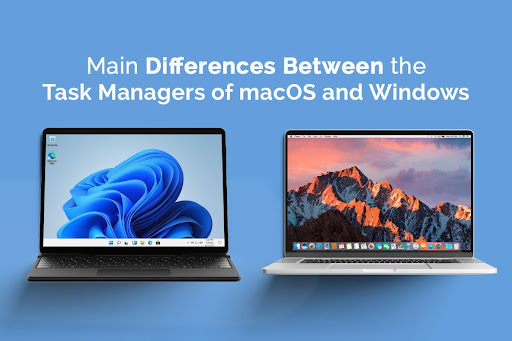
When it comes to the leading computer operating system, the only competition exists between macOS and Windows since only these two are used worldwide by millions of users. These operating systems pack in all the necessary features and functionalities that facilitate a user to perform any computational task easily. Both OS’ are owned and developed by esteemed organizations, which is one of the primary reasons why users from all around the globe prefer these two OSs over others.
Needless to say, both of them have their fair share of differences. According to PCMag, Windows and macOS differ in numerous categories, such as appearance, app compatibility, native features, etc. One of the biggest ones is the task manager. Windows’ native task-managing utility is called Task Manager, whereas macOS’ task manager is known as Activity Monitor. Both the OS’ task managers have numerous differences between them. This article will provide an in-depth insight into the major differences between macOS’ Activity Monitor and Windows’ Task Manager are based on different aspects. Let us get started:
Accessibility:
Activity Monitor – Accessing the Activity Monitor utility is a very convenient task. If you are wondering how to get task manager on Mac, you can conveniently do it in two ways, i.e., by using Spotlight or Finder.
To access Activity Monitor using Spotlight, follow these steps:
Step 1 – Open Spotlight manually or implement the keyboard shortcut (“Command” + “Space”) to do the same.
Step 2 – Type “Activity Monitor”
Step 3 – Click on “Activity Monitor” or press the Enter key when the utility’s name comes up.
To access Activity Monitor using Finder, follow these steps:
Step 1 – Click on “Finder” present on your Mac’s Dock.
Step 2 – Open the “Applications” section present in the sidebar.
Step 3 – Click on “Utilities”
Step 4 – Click on Activity Monitor to open it.
Task Manager – Similar to macOS, Windows also offers numerous ways of accessing Task Manager. Here are some of the most widely-used ones:
- Press the “Ctrl,” “Alt,” and “Delete” keys together.
- Press the “Ctrl.” “Shift” and “Escape” keys together.
- Open the Power User menu by pressing the Windows key and “X” together and click on the “Task Manager” option.
Appearance:
Activity Monitor – macOS’ Activity Monitor features a simple and elegant interface. It has a very minimalist appeal. There are numerous tabs situated at the top-mid of the window, followed by a search tab in the extreme left corner. The five main tabs include “CPU,” Memory,” “Energy,” “Disk,” and “Network.” Users can conveniently look up specific applications, tasks, processes, and options using the search feature. A clean and clutter-free interface paired with powerful features and functionalities make the Activity Monitor an easy-to-use utility for managing applications and processes.
Task Manager – Windows’ Task Manager consists of numerous options and tabs. There are three major menu options, namely “File,” “Option,” and “View,” present in the top-right corner. There are seven tabs below the menu, each of which features different options and functionalities. The tabs include “Processes,” “Performance,” “App History,” “Startup,” “Users,” “Details,” and “Services.” Similar to macOS’ Activity Monitor, the Task Manager displays information about applications and processes in a clean manner.
Features:
Activity Monitor – The Activity Monitor features numerous tabs, each of which has its features and functionalities. For instance, the CPU tab allows users to look at all the ongoing background processes. It also provides them options to terminate the process by force-stopping it. The Memory tab features a detailed description of all the apps’ memory usage. If you find an app is using more memory than usual, you can stop the app using this tab. Similarly, the Energy tab showcases power consumption, and the Disk and Network tab shows disk utilization and network interfaces, respectively. Each tab provides users with the required options to conveniently manage their Mac’s apps and processes.
Task Manager – Windows’ Task Manager is also immensely feature-packed. If you wish to look at all the active processes and apps or take suitable actions, you can navigate to the “Processes” tab and use the available options. Task Manager also allows you to manage startup apps and enable or disable them as your preferences. If you wish to access any app’s performance history, you can conveniently use the “App History” tab to access any app-related info. You want to. If your Windows PC is not performing well, you can navigate to the Task Manager’s Performance tab to determine which app or process is causing the issue by looking at real-time graphs showcasing the use of internal resources. In addition, if you have multiple local user accounts, you can use the Users tab to see which account is consuming how many resources.
Even though both the Activity Monitor and the Task Manager serve the same purpose, they have numerous differences in terms of different aspects, as mentioned above.

Your go-to source for the latest in tech, finance, health, and entertainment, with a knack for distilling complex topics into accessible insights, We deliver timely updates on the ever-evolving landscapes of technology, finance, health, and entertainment




